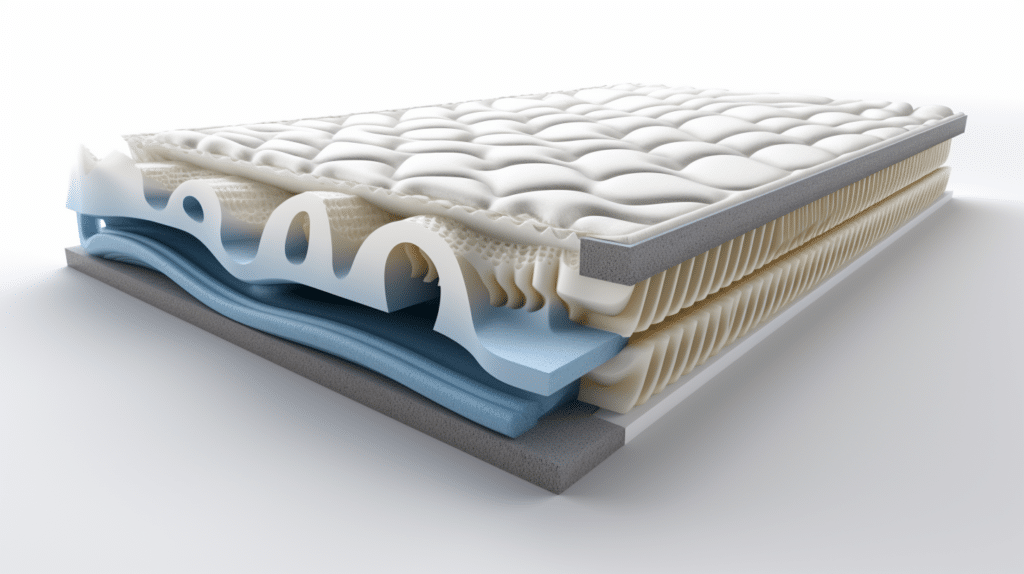Last Updated on August 3, 2023
Mattresses play a crucial role in ensuring a good night’s sleep, and with numerous options available in the market, choosing between foam and spring mattresses can be a daunting task. Foam mattresses have gained popularity in recent years due to their noted benefits in providing pressure relief and contouring support to the body. Whereas, spring mattresses have been a classic choice for sleepers who prefer a supportive and bouncy feel.
Both foam and spring mattresses come with their own set of advantages and disadvantages. While foam mattresses conform to the shape of the body and offer excellent motion isolation, they may retain heat and lack edge support. Spring mattresses, on the other hand, offer better temperature regulation, durability, and edge support but may not provide the same level of contouring support and pressure relief as foam mattresses.
Key Takeaways
- Foam and spring mattresses have distinct characteristics catering to different sleeper preferences.
- Consider factors such as support, comfort, and temperature regulation when choosing between foam and spring mattresses.
- Hybrid mattresses can offer a combination of foam and spring benefits for a balanced sleeping experience.
Foam Mattresses
Foam mattresses have gained popularity in recent years due to their unique properties and benefits. In this section, we will explore four main types of foam mattresses: Memory Foam, Polyurethane Foam, Latex Foam, and Gel-Infused Foam.
Memory Foam
Memory foam, also known as viscoelastic foam, was first developed by NASA in the 1960s for use in cushions and crash pads. Memory foam mattresses provide excellent pressure relief by contouring to the body’s shape, making them an ideal choice for side sleepers. These mattresses also offer great motion isolation, meaning that movement from one side of the bed won’t disturb the other.
However, memory foam mattresses tend to have a slower response time and may not be as supportive as other types of foam. Traditional memory foam can also get warm, as it traps heat, but manufacturers have introduced cooling features like gel-infused memory foam to counter this issue. Additionally, memory foam mattresses tend on the expensive side and may emit an off-gas smell when new.
Polyurethane Foam
Polyurethane foam mattresses, often simply called “foam mattresses”, are a more affordable option compared to memory foam. They come in various densities, providing a range of firmness options to cater to different sleep preferences. High-density foam mattresses tend to be more durable and supportive.
One drawback of polyurethane foam mattresses is that they can have a shorter lifespan than other types of foam. They may also provide less pressure relief than memory or latex foam, making them less suitable for side sleepers or those with pressure points.
Latex Foam
Latex foam mattresses are praised for their responsiveness and supportiveness. They offer pressure relief similar to memory foam while being more responsive, quickly regaining their shape when pressure is removed. This makes them a great choice for people who change positions frequently throughout the night.
Latex foam mattresses are typically cooler than memory foam, as they allow for better airflow throughout the material. They also have a longer lifespan and are often made from more natural materials. However, they can be expensive and may not be suitable for those with latex allergies.
Gel-Infused Foam
Gel-infused foam mattresses combine the benefits of memory foam with the addition of cooling gel. This gel layer helps to wick away heat from the body, providing a cooler sleep surface. Some gel-infused foams also incorporate other cooling elements like copper to further enhance their heat dispersion properties.
While gel-infused foam mattresses can offer a more comfortable sleeping experience for hot sleepers, they still retain some of the drawbacks of memory foam, such as the off-gas smell and a slower response time. These mattresses can also be more expensive than standard memory foam or polyurethane foam models.
Spring Mattresses
Spring mattresses, also known as innerspring mattresses, have been popular for many years due to their supportive and bouncy nature. They use metal coils to provide support and come in a variety of firmness levels, catering to different sleep positions and preferences. This section will discuss four types of spring mattress coils: Bonnell Coils, Offset Coils, Continuous Coils, and Pocketed Coils.
Bonnell Coils
Bonnell coils are the oldest and most common coil type used in innerspring mattresses. These coils are hourglass-shaped and connected to the adjacent coils with a helical wire. The structure of Bonnell coils offers even support to the sleeper’s body weight, promoting proper spinal alignment. They are typically more affordable and budget-friendly, but do compromise on motion isolation and may not be ideal for light sleepers or people sharing the bed. The durability and support layer of a bonnell coil innerspring mattress vary depending on the quality of materials used and the coil count.
Offset Coils
Offset coils are an evolution of Bonnell coils, offering improved contouring and motion isolation. These coils are also hourglass-shaped but feature an S-shaped ‘hinging’ mechanism that allows for better adjustment to body pressure and weight distribution. They typically have a higher coil count than Bonnell coils, resulting in a more durable and supportive mattress. Offset coils are seen in many mid-range to upper-end innerspring beds and are slightly costlier but preferred by sleepers looking for improved comfort while maintaining the traditional bounce of a spring mattress.
Continuous Coils
Continuous coils, or continuous spring mattresses, use a single, long wire to form rows of coils. The wire is bent into an undulating shape, with each row connected by helical wires. Continuous coil mattresses often feature higher coil counts, leading to increased support and durability. These mattresses offer a firm and responsive support layer for sleepers who enjoy an even sleep surface and well-distributed support. However, motion transfer may be an issue in continuous coil mattresses, affecting light sleepers or those sharing a bed.
Pocketed Coils
Pocketed coils, also known as individually encased coils, are the most recent innovation in spring mattress technology. Each coil is wrapped in a fabric pocket, allowing for individual movement, resulting in excellent motion isolation, and a more conforming sleep surface. This design minimises the motion transfer and adapts to the sleeper’s body, providing support to the hips, shoulders, and other pressure points. Pocketed coil mattresses are usually found in hybrid mattresses, combining springs with layers of memory foam or latex, offering a balance of support, comfort, and cooling properties. They tend to be costlier than other spring mattress types but are well-suited for couples and sleepers who prefer a combination of bounce and body contouring.
Hybrid Mattresses
Memory Foam and Spring
Hybrid mattresses are a popular choice for those who want the best of both worlds. Combining the advantages of memory foam and spring mattresses, these options offer excellent support and comfort. Memory foam is known for its ability to conform to the body, providing pressure relief and reducing motion transfer. On the other hand, spring mattresses are praised for their durability and support, especially for spinal alignment.
A typical hybrid memory foam and spring mattress is constructed with a top layer of high-density polyfoam or gel memory foam, which provides contouring support and improved heat dissipation. The bottom layer consists of individually wrapped pocket springs, designed for enhanced support and reduced motion transfer between sleepers. This combination results in a mattress that provides the contouring support of memory foam while maintaining the adaptive, responsive benefit of springs.
Hybrid mattresses can be particularly suitable for side sleepers, as the memory foam layer allows for a gentle sink to relieve pressure on the hips and shoulders. At the same time, the spring layer promotes proper spinal alignment, maintaining a healthy sleeping posture.
Latex and Spring
Another type of hybrid mattress blends the benefits of latex and spring mattresses. Latex is a natural material derived from the sap of rubber trees, offering a bouncier feel and excellent durability. It is also hypoallergenic and breathable, making it a suitable choice for those with allergies or who prefer a cooler sleeping surface.
These hybrid mattresses comprise a top layer of latex, which provides a responsive and conforming surface, while the bottom layer consists of pocket springs. This combination results in a mattress that provides the bounce and cooling features of latex with the supportive nature of springs. Additionally, latex hybrid mattresses are an eco-friendlier alternative to memory foam, as they use a sustainable natural material.
In summary, hybrid mattresses offer a balanced combination of comfort, support, and durability by combining memory foam or latex with spring coils. Both types have their unique characteristics and advantages, making them an attractive choice for sleepers with varying preferences and needs.
Factors to Consider
Sleep Position and Pressure Relief
When choosing between a foam mattress and a spring mattress, it’s important to consider your preferred sleep position and the required pressure relief. Foam mattresses, especially memory foam, excel at contouring to the body, providing optimal pressure relief for side sleepers who need extra cushioning for their hips and shoulders. In contrast, innerspring mattresses tend to be more responsive and supportive, making them suitable for back and stomach sleepers who require more spinal alignment.
Firmness Scale
The firmness level of a mattress significantly affects its overall comfort and support. Foam mattresses, including memory foam and latex, are available in various firmness levels, ranging from plush to extra firm. On the other hand, spring mattresses come with pocketed coils that offer varying levels of firmness depending on the gauge of the wire used in their construction. It is crucial to select a mattress with a firmness level that suits your body weight and sleep preference to ensure a restful sleep.
Motion Isolation and Motion Transfer
Motion isolation refers to a mattress’s ability to absorb movement, preventing it from disturbing a sleeping partner. Foam mattresses are known for their superior motion isolation capabilities due to their dense composition. Spring mattresses, particularly those with pocketed coils, provide decent motion isolation; however, they might still transfer some motion due to the responsiveness and bounciness of the springs.
Heat Retention
Heat retention is another factor to consider when choosing between foam and spring mattresses. Memory foam mattresses are known to sleep hot due to their dense structure, which may not provide optimal airflow. Latex and open-cell memory foam options offer better breathability, while innerspring mattresses typically excel in this area due to their increased airflow between coils.
Durability and Quality
A mattress’s durability and quality are essential factors for long-term comfort and support. High-quality foam mattresses, such as those made with high-density polyfoam or latex, can be quite durable, resisting sagging and indentations over time. Spring mattresses, especially those with pocketed coils, are also considered durable and provide adequate support. Nonetheless, it is crucial to choose a mattress with a good warranty to protect your investment.
Size and Budget
Finally, consider the size and budget when selecting a mattress. Foam mattresses, particularly memory foam and latex options, can be costlier than innerspring mattresses due to the materials used. However, affordable foam mattress options are also available, allowing you to find a balance between price and quality. Spring mattresses come in a wide price range, often making them a more budget-friendly choice. Remember to factor in the available space in your room when choosing a mattress size to ensure a comfortable sleeping environment.
Health and Comfort
Back Pain and Spinal Alignment
Both foam and spring mattresses provide support and comfort to varying degrees, which can be essential for individuals experiencing back pain or those requiring proper spinal alignment. Having the right mattress to support your sleep can indeed have a significant impact on your overall health and comfort.
Foam mattresses, particularly memory foam, are known for their pressure relief and contouring properties. They tend to conform to the body’s shape, distributing weight evenly and reducing pressure points on hips and shoulders, while also offering appropriate support for spine alignment. This is particularly beneficial for side sleepers who require extra cushioning in these areas.
In contrast, spring mattresses offer a more traditional and bouncy feel, with the springs providing the primary support. A well-designed pocket spring mattress can also distribute body weight and support spinal alignment, but it may not contour as closely to the body as memory foam.
Cooling Features and Airflow
Temperature regulation during sleep plays a crucial role in maintaining comfort and ensuring a good night’s rest. Foam mattresses, especially memory foam, have a tendency to retain heat. However, advancements in foam production, such as open-cell memory foam and the inclusion of cooling gel, have improved their cooling capabilities and airflow.
Spring mattresses, on the other hand, naturally allow for better airflow due to the spaces between the springs. This can be advantageous for individuals who sleep hot or live in warmer climates, as the increased airflow can help dissipate heat and promote a cooler sleep environment.
Off-Gassing and Environmental Concerns
Off-gassing refers to the release of volatile organic compounds (VOCs) from a new mattress, which can cause unpleasant odours and sometimes trigger allergies or respiratory issues. Foam mattresses, particularly memory foam, are more likely to emit a chemical smell when new, although this usually dissipates within a few days to a week.
In contrast, spring mattresses generally have fewer off-gassing concerns, as they contain fewer synthetic materials. Still, it’s essential to consider the individual components, such as the materials used in the cover and comfort layers, when assessing the environmental impact and potential health risks.
Ultimately, whether you choose a foam or spring mattress comes down to personal preference and individual needs, considering factors such as back pain, spinal alignment, temperature regulation, and environmental concerns. Your choice should be based on the specific attributes that will provide you with the healthiest, most comfortable sleep experience.
Frequently Asked Questions
What are the main differences between memory foam and spring mattresses?
Memory foam mattresses consist of a viscoelastic material that moulds to the body’s shape, providing pressure relief and even weight distribution. They’re known for their motion isolation properties. Spring mattresses, on the other hand, use metal coils for support. They generally provide more bounce, airflow, and are often firmer than memory foam mattresses.
How do foam and spring mattresses affect back pain?
Memory foam mattresses are known to provide better spinal alignment and pressure relief, which can be helpful for those suffering from back pain. They adapt to the contours of the body, reducing pressure on sensitive areas. Spring mattresses can sometimes exacerbate back pain if the coils do not provide adequate support or correctly conform to the body shape. However, recent research suggests that medium-firm mattresses may improve pain and stiffness during sleep.
What is the difference in price between foam and spring mattresses?
Memory foam mattresses tend to be more expensive than spring mattresses, mainly due to the materials and technology used in their construction. However, prices vary based on brand, quality, and additional features. It’s essential to consider long-term comfort and durability while comparing prices and not focus solely on the upfront cost.
Are foam mattresses more durable than spring mattresses?
Both foam and spring mattresses have their durability thresholds. High-density memory foam mattresses usually have a longer lifespan compared to lower quality foam mattresses. On the other hand, spring mattresses can begin to sag over time, especially if their coils are not of high quality. Ultimately, the durability of a mattress largely depends on the materials used and the quality of its construction.
What are the pros and cons of foam and spring mattresses?
Memory foam mattresses offer pressure relief, contouring support, and motion isolation. However, they can trap heat and may not provide enough support for some sleepers, particularly larger individuals. Spring mattresses offer better edge support, airflow, and bounce, but they may not provide the same levels of pressure relief and motion isolation.
How do hybrid mattresses compare to foam and spring mattresses?
Hybrid mattresses combine both foam and spring elements, offering a blend of pressure relief, contouring support, and responsiveness. They usually consist of a coiled base layer topped with memory foam, latex, or other types of foam. Hybrids can provide a balance of comfort and support for various sleeping preferences and may offer better temperature regulation than all-foam mattresses.



